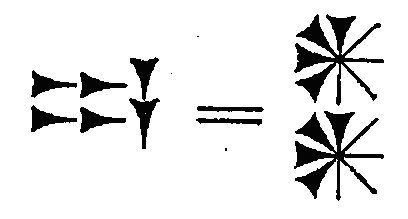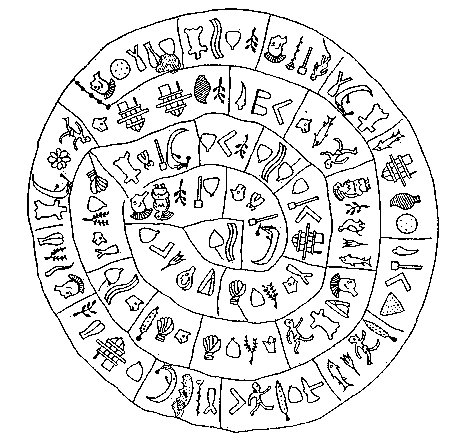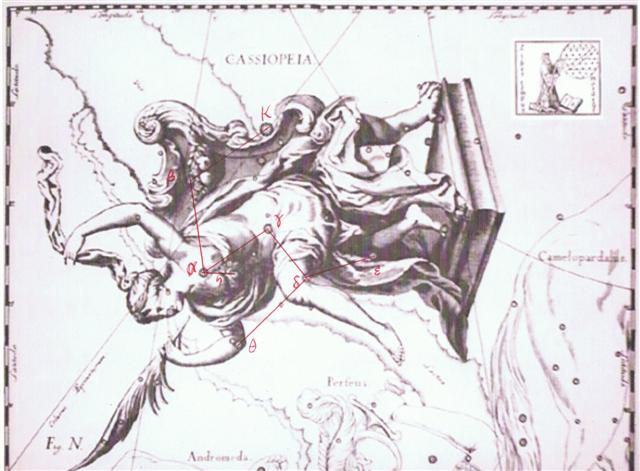TAHUA
7. In the C text we
have found the Heart of the Serpent (Cor Serpentis,
α) at November 14 with the
culmination of the Breast (α
Cassiopeiae, Schedir) 4 days later:
|
 |
*14 |
 |
*3 |
 |
 |
|
Cb1-15 (407) |
Cb2-5 (421, 29) |
Cb2-8 (32) |
Cb2-9 (425) |
|
e niu tu |
koia ra |
Niu |
|
Oct 31 (304) |
Nov 14 (318) |
Nov 17 (321) |
Nov 18 (322) |
|
ZUBEN ELGENUBI (*224) |
COR
SERPENTIS (*238) |
VRISCHIKA (*241) |
SCHEDIR |
|
BHARANI (*41) |
TAU-ONO
(*55) |
ZAURAK
(*58.9) |
ν Tauri
(*59.9) |
|
May 1 (121) |
May
15 (135 = 500 - 365) |
May 18 (138) |
May 19
(322 - 183) |
We should therefore move ahead in the A text accordingly:
 |
 |
 |
|
|
Ab1-5 ( → 25 * 27
= 15 * 45) |
Ab1-6 |
Ab1-7 (1341) |
|
Oct 26 (412 - 6 -
107) = 299 |
Oct 27 (*220) |
ρ Lupi (221.0),
TOLIMAN = α
Centauri
(221.2), π Bootis (221.8), ζ Bootis (221.9) |
|
17 Aug (229 = 299
- 70) |
18 Aug (*150) |
19 Aug |
|
16 Febr (412) |
17 Febr (413
→
14 * 29½ |
(14 * 29½ + 1) → *41.4
Bharani |
| atua ata Rei - tuu
te Rei hemoa |
i ako
te vai |
|
Ako. To sing, to recite:
he-ako i te kaikai, to recite the [text
accompanying a] string figure kaikai;
he-ako i te rîu, to sing rîu. Vanaga.
Song. Ako hakaha'uru poki = 'song to make
children sleep'. Barthel. Ákoáko, to recite
hymns in honour of a deity. Vanaga. |
 |
 |
 |
|
 |
 |
 |
|
Ab1-8 (1335 + 7) |
Ab1-9 |
Ab1-10 (90 + 580 + 10 = 1344) |
Ab1-11 |
Ab1-12 |
Ab1-13 (1347) |
|
29 (→ 152 + 150) |
Oct 30 |
Halloween |
Samhain (*225) |
2 (306 = 123 + 183) |
Nov 3 (*227) |
|
20 Aug (*152) |
21 Aug |
22 Aug |
23 Aug |
24 Aug (236) |
25 Aug (*157) |
| |
|
ZUBEN ELGENUBI |
 |
|
|
|
CLOSE TO
THE FULL
MOON: |
|
April 29 |
30 |
Beltaine (50 + 71) |
|
2 |
3 (123) |
4 |
|
19 Febr |
20 Febr (*336) |
21 Febr (29 + 21) |
22 Febr |
Terminalia |
|
|
|
|
BHARANI |
|
DENEBOLA |
MENKAR |
| Ko te
maitaki - ko te
maharoga |
hetuu e roia |
- |
e
ragi huhuki |
eaha ia |
ko te Rei oho ia mai |
|
Haro. To pull; popohaga o te rua raá, i
haro i te aka o te miro, on the morning of the second day, they
pulled up the anchor of the boat. He haro i te hagu a roto,
to draw in air, to breathe. He-haro te vaka i te au , the
boat is towed off course in the current. Vanaga. a. to point, to
raise the arm, to stretch out the hand or other member, to spread,
to point the yards. b. to hoist, to pull up, to entice. c. to
stiffen, to grasp, to squeeze. Haroharo, to point, to limp.
PS Sa.: falo, to stretch out. To.: falo, to stretch
out, to make tense. Fu.: falo, to stretch out, to lay hands
on. Churchill.
Hu. 1. Breaking of wind. T Mgv., uu,
to break wind. Mq., Ta.: hu, id. 2. Whistling of the wind, to
blow, tempest, high wind. P Pau.: huga, a hurricane.
Churchill. Mgv.: hu, to burst, to crackle, to snap. Ha.:
hu, a noise. Churchill.
|
 |
 |
 |
 |
 |
 |
 |
|
Ab1-14 |
Ab1-15 |
Ab1-16 |
Ab1-17 |
Ab1-18 |
Ab1-19 |
Ab1-20 |
| e honu paka |
e kana ia
- kana rei ia - e heheu ia |
e pure ia |
ka tuu i
te ragi |
|
Paka.
1. Dry; to become dry (of things);
pakapaka, to dry out. Te paka is also the
name of the moss-covered areas, between the small lakes
of volcano Rano Kau, through which one can pass
without getting one's feet wet. 2. To go, to depart;
he-paka-mai, to come; he-oho, he-paka, they
go away. 3. To become calm (of the sea): ku-paka-á te
tai. Pakahera, skull, shell, cranium;
pakahera puoko tagata, human skull; pakahera
pikea, shell of crab or crayfish. Gutu pakapaka,
scabbed lips. Hau paka, fibres of the hauhau
tree, which were first soaked in water, then dried to
produce a strong thread. Moa gao verapaka,
chicken with bald neck. Ariki Paka, certain
collateral descendents of Hotu Matu'a, who
exercised religious functions. Vanaga. 1. Crust, scab,
scurf; paka rerere, cancer; pakapaka,
crust, scabby. 2. Calm, still. 3. Intensive; vera
paka, scorching hot; marego paka, bald;
nunu paka, thin. 4. To arrive, to come. 5. To be
eager. 6. To absorb. 7. Shin T. Pakahera,
calabash, shell, jug. Pakahia, to clot, curdle,
coagulate. Pakapaka, dry, arid, scorching hot,
cooked too much, a desert, to fade away, to roast, a
cake, active; toto pakapaka, coagulated blood;
hakapakapaka, to dry, to broil, to toast.
Pakahera pikea, shell of crab or crayfish.
Churchill. |
|
Nov
4 |
5 |
6 (310) |
7 |
8 (301 + 11) |
9 |
10 (314) |
|
SEPT 1 |
2 (*165) |
3 |
4 |
5 |
6 |
7 (250) |
|
ZUBEN
HAKRABIM |
|
ZUBEN
ELSCHEMALI |
|
|
|
|
|
CLOSE TO
THE FULL
MOON: |
|
ALGOL |
|
|
ZIBAL
(*48.0) |
|
ALGENIB
PERSEI
GIENAH
|
|
|
May 5 (125) |
6 |
7 |
8 |
9 |
10 (*50) |
11 |
When once upon a (long) time ago I tried to cut the A text into
coherent and managable pieces I indeed had perceived these 8
glyphs as presumably belonging together:
 |
 |
 |
 |
|
 |
 |
 |
 |
|
Ab1-21 |
Ab1-22 |
Ab1-23 |
Ab1-24 |
Ab1-25 |
Ab1-26 |
Ab1-27 |
Ab1-28 |
| ka maroa te ragi - e
ragi maú ia |
e ruku
te manu |
ki te ika
- mo tui no te ariki - nuku hakapiri te aha - no te
ariki - e hau tui ika |
mo te ragi |
mo te
manu |
| Nov
11 |
12 |
13 |
COR
SERPENTIS |
|
15 |
16 (320) |
VRISCHIKA
|
SCHEDIR |
|
May 12 |
13 |
14 |
TAU-ONO |
ALCYONE |
17 |
ZAURAK |
ν Tauri
|
The 'bird' (manu - not manu rere → not alive,
not moving) depicted at November 18 -
at 'the
second ceremony of breaking the coconut' -
... The
correspondence
between the
winter
solstice and
the
kali'i
rite of the
Makahiki
is arrived
at as
follows:
ideally, the
second
ceremony of
'breaking
the
coconut',
when the
priests
assemble at
the temple
to spot the
rising of
the
Pleiades,
coincides
with the
full moon (Hua
tapu)
of the
twelfth
lunar month
(Welehu). In
the latter
eighteenth
century, the
Pleiades
appear at
sunset on
18
November.
Ten days
later (28
November),
the Lono
effigy sets
off on its
circuit,
which lasts
twenty-three
days, thus
bringing the
god back for
the
climactic
battle with
the king on
21 December,
the solstice
(= Hawaiian
16
Makali'i). The
correspondence
is 'ideal'
and only
rarely
achieved,
since it
depends on
the
coincidence
of the full
moon and the
crepuscular
rising of
the Pleiades
...
appears to be
female, due to how her beak has been drawn.
And the eye-catching
design of her wing up in front could be indicative of a
gravitational flow
downwards. This would fit with the idea of a
'milky river'
emerging high up from the Breast of Cassiopeia.
... At top center of the bottom side of the
Phaistos Disc we have found the Breast (Schedir which
culminated at 21h in November 18) together with its
outflow in form of the Milky Way
river.

When a coconut shell is forced open its nourishing
interior, a milky substance, will flow out.
... Of course! Such a nut will, if it is
broken, generate a milky fluid similar to that from a woman's
breast! Both were cues for thinking of the Milky Way.
Therefore the
culmination (at 21h) of the star named Breast (viz.
Schedir in Cassiopeia) had to coincide with November 18 ...

|














